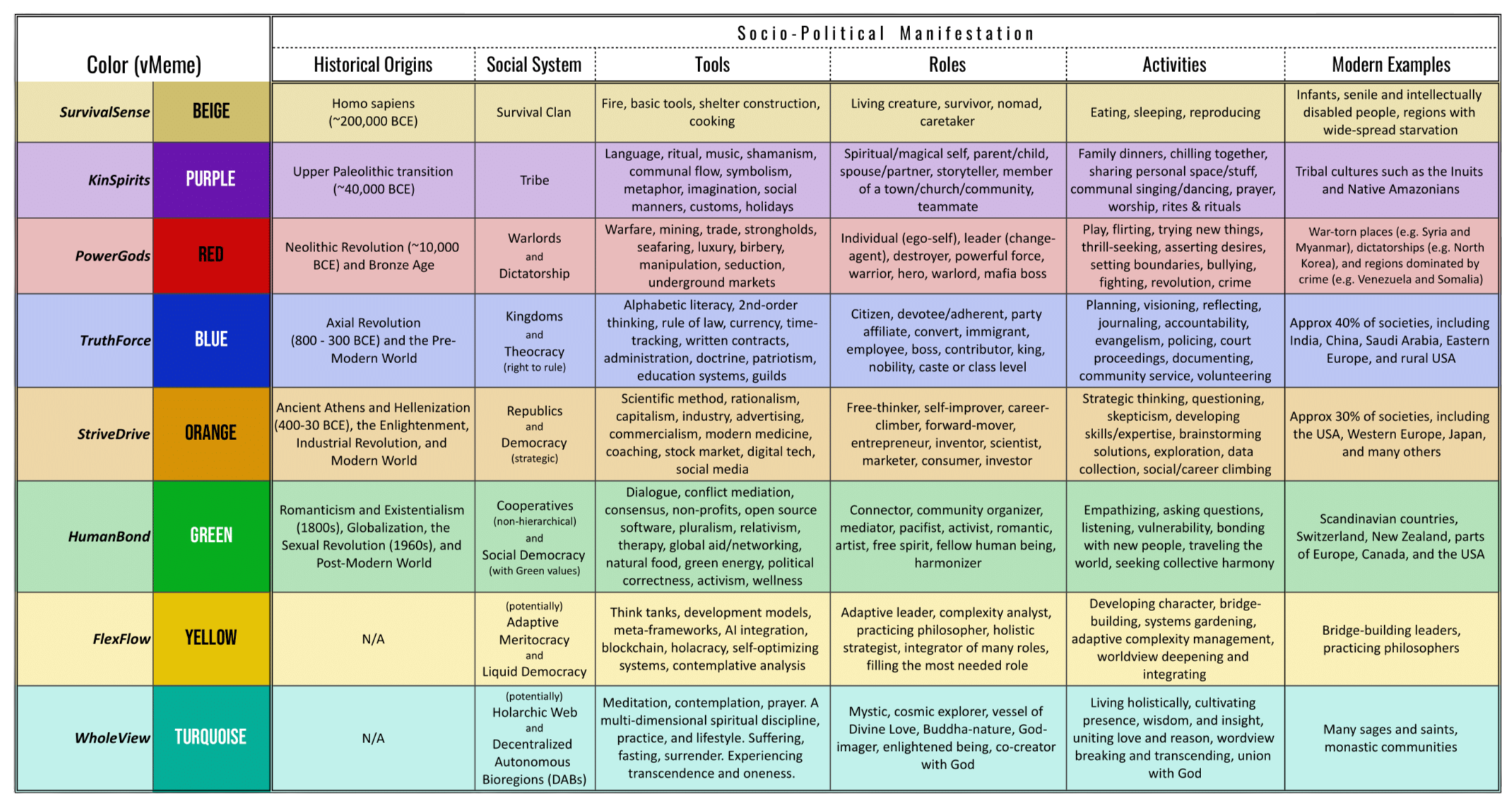Spiral Dynamics: A Framework for Everything
If you’ve known me long enough, you’ve probably heard me talk about Spiral Dynamics. After the Enneagram, it’s the framework I reference the most! It’s useful for SO many things, and has helped me immensely with personal growth! I’ve worked with the Spiral for over a decade now, and have added my own touches to the theory 😊 So whether you’re a friend reading this or a stranger pursuing the latest on Spiral theory, I’m excited to share the Spiral with you!!
Spiral Dynamics Introduction
Spiral Dynamics is a development model which provides a language for understanding human (individual) and societal (collective) development, across many domains such as conflict resolution, geopolitics, motivational schemas, human needs, psycho-social development, education, political systems, and more!
It was developed by Clare Graves (1960s) and refined and expanded by Don Beck and Christopher Cowan (1980s). It can be seen as a synthesis or meta-model of many development models, such as Maslow’s needs, Gebser’s worldviews, Piaget’s cognitive capabilities, Erickson’s psychosocial life stages, Fowler’s faith stages, Kegan’s social–emotional framework, and Cook-Greuter’s leadership maturity.
The first key to understanding the Spiral (and why it’s shaped like a spiral) is that each level “transcends and includes” the others. That means that Purple includes Beige. And that Red includes both Purple and Beige. Blue includes Red, Purple, and Beige. Etc. Thus every time the spiral “loops” around, it’s back at the “same point,” but also at another level (hence spiral!). Thus Spiral theory states that each color is built upon the previous, meaning that a person (or society) that is “progressing through” the Spiral, never really leaves-behind the previous levels, but builds upon them.
The second key to understanding the Spiral is that there is no best color. Higher colors aren’t better even though they are more progressed and lower colors aren’t better even though they are more foundational. Certain life-conditions may make one color more adaptive than another, and certain situations may be better addressed by one color or another, but all colors have their proper place and are essential in their own way.
Also key to the Spiral theory is the pendulum-swing between Individual (I) colors and Collective (We) colors. This back-and-forth movement is because all of us must move between self-focus (my needs) and self-sacrificing (the needs of others). This is an individual-collective dialectic that we all individually deal with… and which we see expressed in cultures as they develop and move between the two poles.
Below is further explanation of the Spiral Dynamics framework in a sheet which I use in my seminars, which should help you begin to grasp what each color is about:
Socio-Political Development Table
The folks who created the Spiral did lots of research on current cultures and cultures of the past. The colors of the Spiral are associated with the emergence of different social systems. Below is a table which lays-out many of these associations, with both historical origins and modern examples of societies which have particular colors as a primary influence / dominant expression. I caution against broad-stroking any culture as a single color, for every culture exhibits aspects of multiple colors, and is spread across some range of the Spiral. In a globalized world like today, even a country that’s primarily exhibiting attributes of one color will certainly have pockets and seeds of all the higher colors as well. That said, societies do naturally progress through the colors sequentially, as each color builds upon and responds to the problems of the previous (and we can see this emergence historically).
Personal Worldview Table
The Spiral is also very useful for understanding individuals and how they perceive the world. Every color is a lens through which someone can look — seeing the world through Purple familiarity, Red power, Blue duty… etc. These lenses can be taken on and off (and multiple looked-through at the same time), but oftentimes people will have a favorite or most-influential lens.
These lenses involve seeing the world through certain values… which in turn leads to certain strengths and weaknesses. Any color can be expressed with virtue or vice, so one might say there is a high-side and low-side to each. Healthy and virtuous people will express the strengths and avoid the weaknesses. Thus there is much diversity and growth to be had within each color. Many people have spent nearly their whole life seeing primarily through one color… and some have done this in a static way… and others in a dynamic way full of movement and improvement within their lens/valueset!
Each color is also focused on meeting certain human needs… for instance Red is focused on autonomy and freedom, whereas Blue focuses on the (largely opposite) needs of stability and duty. Every person has a need for all these things (consider how I frame it in my Dialectical Needs model), and thus every person will likely tap into every color to some degree with regards to their needs.
We also can identify trusted sources of authority for every color and an associated moral reasoning for why they think some things are good and others bad. Many disagreements and misunderstandings between people (and cultures) stem from these different ways they discern goodness/morality.
It might be helpful to consider…
Which lens do I use the most?
Do I use the other lenses in different contexts?
Is there a lens I almost never use?
Is there any color through which I would like to see the world more often?
If you enjoy personality assessments, I’ve created a little Spiral Dynamics Quiz that will give you a level of each color!
Conclusion
There’s a lot more to say about the Spiral, and I have several more articles coming down the pipeline! Which aspects of the Spiral peaks your interest the most? Please share any questions or thoughts you have below!
Here’s a combined table image, including bonus associations with Erickson’s Psychosocial Stages and Fowler’s Faith Stages:



